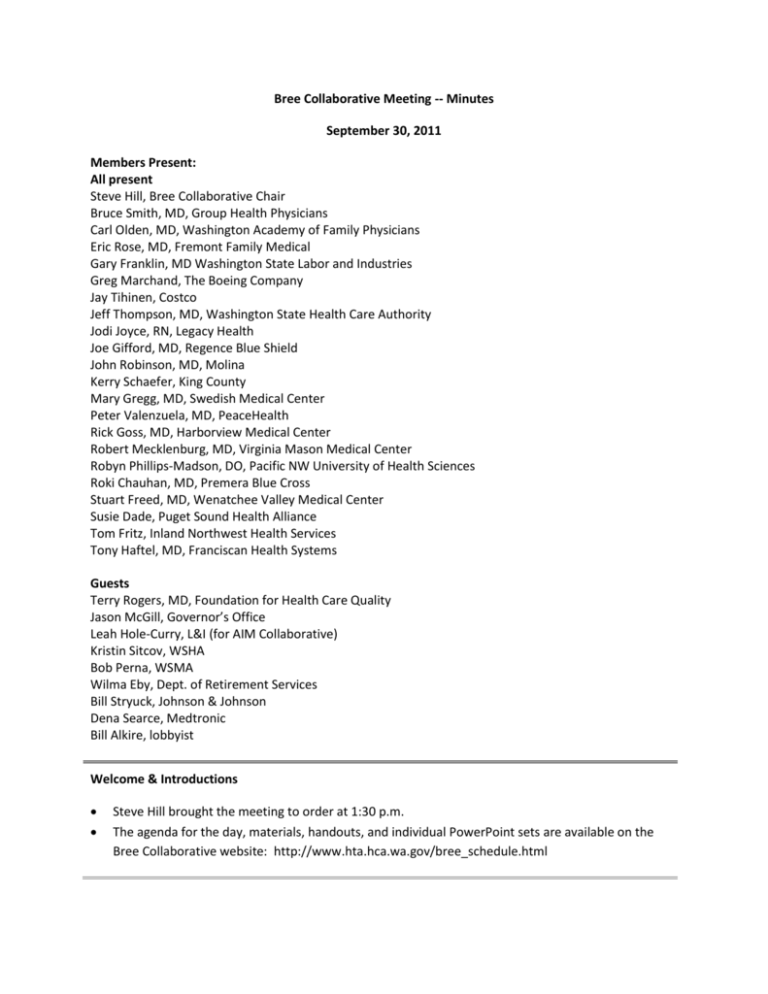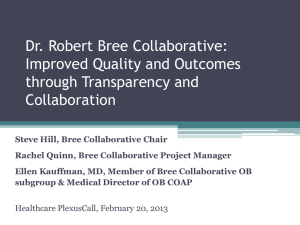Meeting Minutes - The Bree Collaborative
advertisement

Bree Collaborative Meeting -- Minutes September 30, 2011 Members Present: All present Steve Hill, Bree Collaborative Chair Bruce Smith, MD, Group Health Physicians Carl Olden, MD, Washington Academy of Family Physicians Eric Rose, MD, Fremont Family Medical Gary Franklin, MD Washington State Labor and Industries Greg Marchand, The Boeing Company Jay Tihinen, Costco Jeff Thompson, MD, Washington State Health Care Authority Jodi Joyce, RN, Legacy Health Joe Gifford, MD, Regence Blue Shield John Robinson, MD, Molina Kerry Schaefer, King County Mary Gregg, MD, Swedish Medical Center Peter Valenzuela, MD, PeaceHealth Rick Goss, MD, Harborview Medical Center Robert Mecklenburg, MD, Virginia Mason Medical Center Robyn Phillips-Madson, DO, Pacific NW University of Health Sciences Roki Chauhan, MD, Premera Blue Cross Stuart Freed, MD, Wenatchee Valley Medical Center Susie Dade, Puget Sound Health Alliance Tom Fritz, Inland Northwest Health Services Tony Haftel, MD, Franciscan Health Systems Guests Terry Rogers, MD, Foundation for Health Care Quality Jason McGill, Governor’s Office Leah Hole-Curry, L&I (for AIM Collaborative) Kristin Sitcov, WSHA Bob Perna, WSMA Wilma Eby, Dept. of Retirement Services Bill Stryuck, Johnson & Johnson Dena Searce, Medtronic Bill Alkire, lobbyist Welcome & Introductions Steve Hill brought the meeting to order at 1:30 p.m. The agenda for the day, materials, handouts, and individual PowerPoint sets are available on the Bree Collaborative website: http://www.hta.hca.wa.gov/bree_schedule.html Background and History of AIM: AIM was the predecessor collaborative. Leah Hole-Curry, former Health Care Authority program manager who worked on the AIM efforts, presented. Members provided handout of the outcome reports (http://www.hta.hca.wa.gov/documents/aim_report-2009-08.pdf and http://www.hta.hca.wa.gov/documents/aim_phase_final_report.pdf). AIM product proved a huge success for L&I in terms of improving quality and reducing costs. However, AIM did not achieve a statewide solution as envisioned. Nonetheless, a few members on the Bree members were also members of the AIM, and they stated that the collaborative provided real value, which led to the creation of the Bree. AIM provides good lessons learned and foundation for Bree. Expectations of Legislation: See: http://www.hta.hca.wa.gov/documents/Bree_Outcomes_McGill.pptx Jason McGill, Governor’s Health Policy Advisor, provided an overview of the legislation and the expectations for the group. Bree is named after Dr. Robert Bree, who was a member of AIM and recently passed away. He was a leading evidence-based radiologist at the UW/Harborview. Bree Members who knew him spoke fondly and honored his memory. Jason outlined that: The collaborative shall identify health care services for which there are substantial variation in practice patterns or high utilization trends in Washington state, without producing better care outcomes for patients... And that: By July 2012 develop at least one impactful state-wide solution to a significant health care problem in our state. Summary of criteria to consider in selecting topic to include substantial variation, high utilization and inefficiency in care delivery, patient safety issues, and whether there are proven means/strategies to address this topic (leverage other opportunities) to scale-up efforts that are working well. Once Bree selects a topic, it should form a clinical committee, consider other efforts, and provide an opportunity for public comment. Solutions and strategies should include, but are not limited to: Identifying goals for appropriate utilization and variation; peer-to-peer consultation or second opinions provider feedback reports use of patient decision aids incentives for appropriate use of health care services centers of excellence or other qualification standards quality improvement systems service utilization and outcomes reporting research to improve care quality and outcomes Then the full Bree committee should vote on the proposed solutions and strategies. The recommendations go to the administrator of the Health Care Authority to thoroughly review and decide whether they should be applied to all state purchased health care programs (Medicaid, PEBB, L&I, & DOC). This is not a coverage decision for private payers. Following the Administrators review, Bree should report to the Legislature and the Governor. Funding: Steve discussed potential of HRSA grant, contributions by member organizations, and perhaps forming a grant sub-committee. Group proposed that we return to this issue once we have more detail about estimates (see follow up item to raise $60,000: http://www.hta.hca.wa.gov/documents/bree_budget_proposal.pdf) We discussed possibility for federal SHAP grant funds as initial startup. Discussion – Potential First Areas of Study: Steve led discussion about survey results regarding what topics to discuss for possible selection (see: http://www.hta.hca.wa.gov/documents/bree_survey_summary.docx). Steve proposed Bree goals could include: e.g. one quick win, one longer term project. 1. C-Sections and Convenience Inductions: o Dr. Thompson presented (see: http://www.hta.hca.wa.gov/documents/CSection_Rates_Thompson.ppt) o Group discussed that the goal is hard to define, so would take some work, but generally agreed that it was a ripe to select because of the high variation and that so much work has already been done (Medicaid, Joint Commission, Perinatal Collaborative, WSHA). o Greg Marchand, Boeing, thought this was a good topic, noting that it seemed like Bree could bring this one to the finish line. o Dr. Haftel, noted the success at Franciscan, using hard stops and believes that feedback report would work, although some will argue the details. 2. Cardiology procedures: o Dr. Gifford proposed this topic and discussed that the use of appropriate guidelines could reduce variation. o Dr. Gifford thought this was a good topic because the guidelines and tools already exist, they just need adoption. 3. Preventable Hospital Readmissions: o Dr. Thompson presented (see: http://www.hta.hca.wa.gov/documents/Readmissions_Thompson.ppt ) o Dr. Thompson discussed that we do not have a useful DRG code; that CMS has already taken action on 30-day readmits. o Discussion about excluding certain conditions like cancer due to the necessary inpatient follow up treatment for chemo. Discussion about mandating checklists, Dr. Flum’s COAP tool. Jodi commented that there are delivery system elements that do not yet exist that could be quick wins. Susie mentioned the STAR program at WSHA. 4. Management of Early Stage Prostate Cancer: o Dr. Rose presented (see: http://www.hta.hca.wa.gov/documents/bree_prostate_cancer_er.docx)Group o Discussed that shared decision making could be an effective tool. Communication key. o Dartmouth Atlas decision aides already out there. o Some barriers exist because of specialty practice (urology/oncology). Very expensive. 5. Complex Back Surgeries: o Dr. Franklin presented (see: http://www.hta.hca.wa.gov/documents/Spinal_Fusion_Franklin.pptx) o Discussed the difficulty with low back fusion surgery for pain patients. Outcomes have not been good, and there’s high variation across state and country. o Regence and Premera have in place a guideline review, and do not cover uncomplicated o o o o o o pain cases. State purchasers must cover (with conditions) due to Health Technology Assessment program state decision. More evidence is needed to show effectiveness/ineffectiveness. Dr. Franklin suggests a letter of support to Dr. Flum’s Spine-SCOAP program, but emphasizes that prospective comparative effectiveness research must be done, not just a registry. Dr. Mecklenburg notes that Virginia Mason has applied an evidence based approach, working with employers, noting that this was a strong interest of employers to avoid unnecessary surgery and return employees to health and function fast (and save money and time-loss). Dr. Freed noted the variance and the high tendency for opioid pain medication posttreatment. Group discussion, generally supporting SCOAP approach. Pick First Topic & Determine Process Group discussed process for selection. Reviewed legislation and requirements. Group confirmed that a quick win would be good. Steve asked for the employer representative perspectives: o Kerry Schafer, King County, emphasized that employers want high impact solutions for employees to provide high quality and reduce costs. o Kerry notes that King County is looking very carefully at pricing and outcome depending on provider – notes high value in Group Health because of its integrated system – “integrates quality” o Kerry also notes that KC has a health economist on staff now. o Jay Tihinen, Costco, supports all efforts, but notes that Costco has an expensive plan, and would like to make employees better consumers and wants providers to engage employee/patients with decision aide tools. o Jay notes the high costs for Costco are maternity and muscular-skeleton o Also notes that Costco does not want to present access to care barriers for employees. o Jay mentioned Safeway’s approach to reference pricing, and that Costco is looking in to it. o Tom Fritz, Inland, emphasizes measurement for efficiency, cost and outcomes as a key outcome/strategy on any topic selected. He says “let’s go!” Group agrees to put topics to a vote. The members approved the process. Group thought the method employed to present possible topics worked well; and in fact enjoyed the discussion, and feel sufficiently informed about voting. Group decided to give each member two votes (because Bree intends to take up more than one topic as it goes forward, but would like to prioritize accordingly). Group voted: VOTE OUTCOMES: 1. 2. 3. 4. 5. c-section/maternity care: 15 votes Readmissions: 10 votes Complex back/low back: 7 votes Cardiology: 7 votes Prostate Cancer: 1 vote Group decided to prioritize 1. C-section/maternity care and 2. Readmissions Group decided to form sub-groups for 1. C-section/maternity care and 2. Readmissions. State Budget Brief Jason McGill, Governor’s Health Policy Advisor, presented: Considering the very difficult budget deficit caused by the great recession and further turmoil this summer in Europe and lack of timely action in Washington DC that almost resulted in a government shut-down, Washington State sales tax revenue has dropped precipitously by $1.5 billion worse than just expected in March. Possible cuts include Basic Health (35,000 people), Disability LifeLine, Long Term Care, etc. these are awful; up until now, we’ve been able to avoid major cuts to safety net programs. Jason emphasized the time is now, that we have no more time for pilot projects. He emphasized that health care has the best and brightest – it’s the not problem that we don’t know what to do – it’s that we can’t seem to scale-up good ideas in a swift and timely manner. We’re wasting billions (trillions) in health care. Health care inflation growth is why we can’t fully fund education. Governor’s priority is an affordable health system for our state citizens, business, to remain competitive, locally and globally. Lawsuits are tying our hands and not effective solutions. The Bree Collaborative is in a unique position to make a real positive impact – to scale-up good ideas – the Governor is optimistic and challenges the Bree to lead the way! Organizational Items By-Laws – Discussed briefly, handed out a copy (see: http://www.hta.hca.wa.gov/documents/bree_bylaws.doc) Did not vote on by-laws. Vice Chair & Steering Committee – Steve mentioned his plan to consider a vice-chair and perhaps an organizing committee. Members thought that was a good idea. Next meeting – Members agreed to meet as needed, and schedule accordingly. Adjourned 5 p.m.









